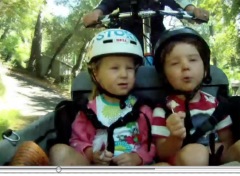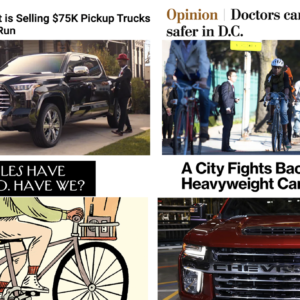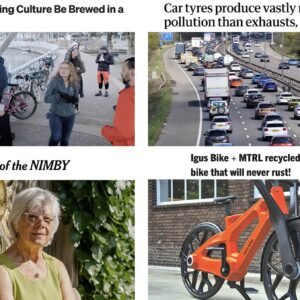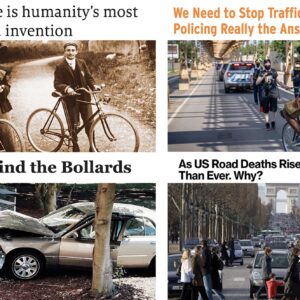
documentary about cargo bikes.
Welcome to Monday. Here are the stories that caught my eye this past week…
— Big news in Richmond Virginia. That city has been selected to host the 2015 UCI World Championships Road Race. That’s a very big deal. Organizers estimate the event will generate about $135 million for the state.
— In Japan, a man is walking the streets is ringing a bike bell to see how people react. “The results are near Pavlovian, because as soon as the people hear the bell, they instinctively move out of the way.” There’s even a video.
— In other Japan news, according to the Cycle Wellington blogger, children are required to wear a helmet while walking to school.
— Several people (including my mom!) have emailed me about Revolights, which appear to be the hot thing on Kickstarter right now.
— In other exciting Kickstarter news, two very cool bike projects were funded late last week: the ‘Conscious Commuter’ folding e-bike and the Ginger Ninjas cargo bike music tour.
— I love this “Bike Tech at School” program in Santa Cruz, California. It’s like auto shop, but with bikes and it’s run through the Regional Occupation Program.
— Interesting advocacy note from Marin County, California. That area’s influential bicycle advocacy group, the Marin County Bicycle Coalition, has decided to embrace the off-road trail access issue and hire a full time off-road advocacy director.
— The Atlantic’s new “Cities” publication took up the “Bike lane backlash” in North Portland.
— And the Williams Ave project was also mentioned in a New York Times Business section article about Portland’s bike-oriented development.
— In case you missed it, the Lovely Bicycle blog had a dreamy roundup of the most elegant transportation bikes that were shown at the big Interbike trade show this year.
— Here’s one to add to your debate file when someone mentions how much exhaust you breathe while bicycling. A study finds that “Car fumes ‘raise heart attack risk for six-hour window’“.
— There was much ado about Ford’s new e-bike concept.
— A strange juxtaposition of competitive cycling and cycle chic as the Road World Championships were held in the Copenhagen.
— Also from Copenhagen, and in honor of the return of rainy skies in Portland, have you seen Mikael Colville-Andersen’s photoset of people bicycling with umbrellas?
— From Washington D.C., comes yet another ancillary benefit of bike share systems: They offer researchers an excellent pool of easily trackable subjects. A new, year-long study will look at how regular use of Capital Bikeshare impacts mental health patients.
— Speaking of Capital Bikeshare, it’s going so well that there are plans afoot to expand it considerably next year.
— Have you read noted Portland architecture blogger Brian Libby’s recent piece on the Columbia River Crossing project? Here’s a snip:
“this Mt. Everest of political and transportational folly is about to coagulate into an unfortunate future. Dr. Frankenstein’s monster (actually, Dr. Gregoire-Kitzhaber’s) is being lifted out of the castle and up to the roof, preparing for the lightning shock that will lurch it into a living breathing terror of concrete and wasted greenbacks.”
— Our friend Clarence Eckerson (of Streetfilms fame) passed along this YouTube clip from the opening scenes of a 1978 movie called Americathon. Watch it and you’ll understand why.
— A woman was struck and killed while bicycling in Cottage Grove, Oregon when she attempted to cross a rural road while on a rail-trail.
— If you haven’t seen the October issue of Bicycling Magazine yet, here’s the big article on cargo bikes (featuring lots of Portlanders) that I wrote about last week.
— Speaking of Portland’s cargo bike scene, filmmaker Liz Canning is working on a documentary about cargo bikes and she just released the trailer. The film features many Portlanders and some of the footage is being shot by local videographer Dan Kaufman.






Thanks for reading.
BikePortland has served this community with independent community journalism since 2005. We rely on subscriptions from readers like you to survive. Your financial support is vital in keeping this valuable resource alive and well.
Please subscribe today to strengthen and expand our work.
I saw the revolights a while ago but dismissed them since the headlights seem to be rather dim and looks like there could be braking interference issues for folks with rim brakes.
The NYT article link goes to The Atlantic. Probably not intended.
Can we stop calling them e-bikes and start calling them what they are? Motorcycles.
And we should start calling traditional bicycles “leg cycles”
They do call them “push-bikes” in Scotland.
no.
Would that mean Tony would forfeit his new award?
No. The reason? Because they’re not. About 30 seconds with the search engine of your choosing will explain further, should you need it.
I’m surprised that people bicycle with umbrellas. There seems to be a logical disconnect here, and one that should be obvious to anyone who has ever used an umbrella in Portland, what with the gorge wind…
They bike SLOWLY with umbrellas.
If you are going into the wind, it’s not a problem. It also helps to have a rear coaster brake (like most bikes in Copenhagen do), so you can safely have a hand free for the umbrella.
Slower than walking? Because that’s how slow you’d have to go for it to work, based on walking with an umbrella. Seems like real raingear is better if you’re actually moving or standing in wind.
I would have to agree…I guess you use what you got. Being from Troutdale, you’d have to be “dumber than brave” to even consider this idea. So consider this…a “Rainfish umbrella” tested and designed in Troutdale.
Glad to see Revolights doing so well. I am a backer and can’t wait to install those lights on my commuter bike. I won’t be getting rid of my nice headlight, but I sure like the extra visibility for motorists the Revolights offer. They are much more improved then their pre-kickstarter version and and clip to the spokes just under the rim, so rim brakes are out of the way.
Those Revolights look interesting. One evening last winter I was broadsided by a car that was toodling through a two-way stop sign as I was riding through a SE Salmon intersection. Demonstrating that just because you’ve got the right of way (on a bike boulevard no less), and covered with reflective clothing doesn’t mean the idjits will see you. Luckily the car was only going 5mph or so. Anyway, it got me thinking that being highly visible from the side can be as valuable as being seen from front and back, especially in the city.
From the Ford E-bike story:
“…With a range of around 85 kilometers, the bike also features magnetostriction sensor technology, which converts magnetic energy into kinetic energy. It’s commonly used in the racing world. …”
What the hey is ‘magnetostriction sensor technology’? Is it similar to the technology used to power some bike headlights using dynamo hubs? Bike looks like a concept rig that nobody with a modest income could afford.
Fuel getting ever more expensive and peaking out, it’s logical that big auto manufacturers would consider making inroads to the e-bike market. And also, for potential buyers to deal with, there’s the increasing pressure to feel guilty about driving around such big vehicles.
Buy a big honkin’ 4 wheel drive Excursion….Ford could throw one of these e-bikes in on the deal for free. Strap it on to the monster truck, and the customer is good to go, riding it around the rest stop, from the motel to the restaurant, or the marina, just in case they want to demonstrate their green consciousness.
“Our advice to patients remains the same – if you’ve been diagnosed with heart disease, try to avoid spending long periods outside in areas where there are likely to be high traffic pollution levels, such as on or near busy roads.”
How about advising patients to advocate for lower pollution solutions to transportation like mass transit, bicycle and pedestrian infrastructure?
If you are advocating against the single occupancy automobile you are advocating that people make themselves social pariahs.
Don’t like it but it’s true in America.
Plus all that wasteful spending on autos props up the economy. Fear mongering says that we should not do anything that might result in a loss of employed citizens.
“Fear mongering says that we should not do anything that might result in a loss of employed citizens.”
Try telling that to one of the millions unemployed or of the millions about to lose their home. Fear mongering? Maybe. Calloused? Most certainly.
I am sure that there are hundreds, possibly thousands of people that work in the greater Portland/Vancouver area that carpool (in my office of 12, 5 carpool). Does that make them social pariahs? Or does does one have to choose not to own an automobile even though they can afford one?
Don’t worry, the fear mongering is winning.
If pointing out that short term economic gain that undercuts and sabotages long term societal and governmental stability is calloused then I’m Greg House. There is only so much of today that you can toss in to the fires of progress before tomorrow disappears.
Unfortunately yes. Apply for a job: it doesn’t matter where, what or your qualifications but when they ask “Do you have a car?” ask yourself later why you didn’t get that job.
It is a well known fact that in America a car is a symbol of economic and social status; heck it’s the primary advertising hook used in pushing autos on the public. People judge other people, fairly or unfairly, by how they appear. Because the automobile is so ubiquitous it is a de facto part of personal appearance. A lack of car is often taken incorrectly as a sign of a lack of skill or intelligence needed to hold even the most mundane employment that would allow the average person to purchase the most important tool they need in their daily life.
Most people that don’t conform to the norm choose to. Seeing that we (the USA) have built ourselves in to an infrastructure dead end dedicated to the car we are at least stuck with it until we have the funding to change massive social and economic upheaval radically change our transportation priorities.
I was never asked whether I own a car for any of the jobs that I have applied for or achieved. This is certainly not true at Intel. I have done interviewing at the other side of the desk (interviewer) and we were *never* instructed to ask whether or not an applicant has a car.
I’ve been told at multiple companies that we can’t ask questions about commutes or car ownership. We could ask “Can you start work at 7 AM?”, but not “How long is your commute?” or “Do you have a car?”
That trailer for Liz Canning’s cargo bike documentary is all kinds of inspiring! Well done, co-directors.
“Cargo bike movie” —> “released the trailer”! Beautiful.
Another study with bad news for cyclists in major cities. Found it today on the New Yorker’s website.
http://www.eurekalert.org/pub_releases/2011-09/elf-cca092311.php
“City cyclists are at increased risk from lung injury from inhaled soot”
Yep, it’s all over the place. How come they’re not covering the amount of death’s caused by driving this month alone? http://www.latimes.com/health/boostershots/la-heb-cyclists-pollution-20110926,0,3792100.story
“And John Ritter, as The President”
Meatloaf?!!! George Carlin?!
Wish this was what resulted from the recent “Carpocalypse”!
The death of the Cottage Grove lady is terrible. Especially how it’s described. It sounds like she was legally crossing the road and a truck comes around a corner and kills her. Apparently, the truck driver did nothing wrong. Just bad luck for both of them. Ridiculous.
OregonLive’s story on this collision has some helpful information provided in page two of the comments by Joni Portmann (says she’s Michelle’s sis) and Jeffery Egbert.
http://www.oregonlive.com/pacific-northwest-news/index.ssf/2011/09/cottage_grove_woman_killed_whe/8001149/comments-2.html
“People who haven’t been out to this location do not understand how hazardous it is. This path is on a sweeping corner and the direction from which they were coming makes it partially blind to both parties involved. …” Jeffery Egbert
“Bottom line? No one is at fault except the designers of this path. …” Joni Portmann
Actually, in the comment the above excerpt was taken from, she goes on to acknowledge errors both her sis and the driver of the truck made as they approached the collision site. The errors they made though, would seem to be the type of risks many, probably most road users make on occasion, due to visual challenges arising from roads that were poorly designed for a service that differs from ones they were originally designed for.
Poorly selected and sited landscape materials can be a major traffic hazard; for example, the trunks of rows of newly planted trees and bushes that directly block road users view down the road to traffic entering from intersecting roads. This causes people to have to pull their vehicle into the intersection and the path of passing vehicles, to see around the obstacles posed by the planted material.
Poor design judgments like this result in even greater visual obstruction when road users have to deal with the outside curve of streets.